Navigational near-miss in restricted visibility
- Safety Flash
- Published on 16 April 2014
- Generated on 10 July 2025
- IMCA SF 06/14
- 2 minute read
Jump to:
A Member has reported a near miss incident in which an offshore wind farm crew transfer vessel (CTV) avoided another vessel in its path during a period of restricted visibility.
What happened?
The incident occurred when the vessel was on passage along the designated wind farm traffic route. It entered a fog bank which resulted in visibility being reduced to less than 100m. Upon entering the fog bank, the Master reduced to minimum steerage way, posted a lookout in the wheelhouse and commenced making sound signals as required by International Maritime Organization (IMO) collision regulations. In addition to this, a second crew member prepared to mount a watch on the foredeck, and the intercom external speaker was activated to monitor for sound signals of other vessels.
Another vessel ahead was sighted at less than 100m away. It was at anchor in the wind farm traffic route. The Master immediately stopped the CTV and then proceeded slowly around the anchored vessel, which was not making any sound signals nor was an Automatic Identification System (AIS) signal noted. Although the CTV had radar operating on the 2 mile range the anchored vessel was not detected. This incident was reported to the UK Marine Accident Investigation Branch (MAIB) and the client.

Showing fog from bridge of CTV
Our member’s recommendations included:
- Amend the generic risk assessment for navigation, along with the company procedures for small vessel operations, to reflect this incident.
- Ensure Masters are aware of their radar settings, as improperly adjusted rain and sea clutter or gain settings can affect reception.
- Ensure Masters are able to use known objects such a channel buoys to confirm correct calibration.
IMCA Safety Flashes summarise key safety matters and incidents, allowing lessons to be more easily learnt for the benefit of the entire offshore industry.
The effectiveness of the IMCA Safety Flash system depends on the industry sharing information and so avoiding repeat incidents. Incidents are classified according to IOGP's Life Saving Rules.
All information is anonymised or sanitised, as appropriate, and warnings for graphic content included where possible.
IMCA makes every effort to ensure both the accuracy and reliability of the information shared, but is not be liable for any guidance and/or recommendation and/or statement herein contained.
The information contained in this document does not fulfil or replace any individual's or Member's legal, regulatory or other duties or obligations in respect of their operations. Individuals and Members remain solely responsible for the safe, lawful and proper conduct of their operations.
Share your safety incidents with IMCA online. Sign-up to receive Safety Flashes straight to your email.